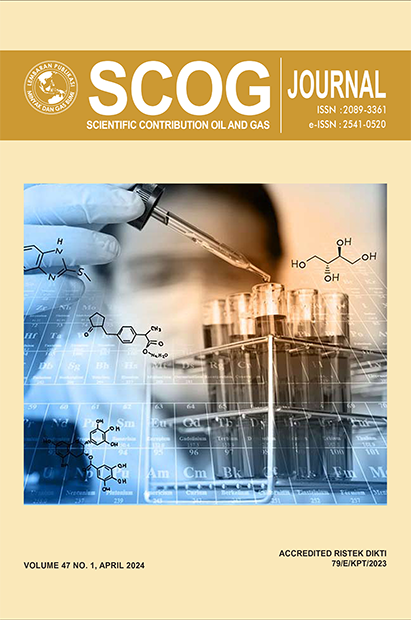Updated Geochemical Characterization of Hydrocarbon Potential of Surface Sample in Lariang-Karama Sub-Basin, West Sulawesi, Indonesia
DOI:
https://doi.org/10.29017/SCOG.47.2.1624Keywords:
source rock, West Sulawesi, total organic carbon (TOC)Abstract
The Lariang-Karama Sub-Basin is situated within the Makassar Basin, located in the West Sulawesi region. It has source of rocks which has the potential to produce hydrocarbons and to become a target for new field discoveries in hydrocarbon exploration activities. It is on this basis that the authors are interested in conducting research in the Makassar Basin area and its surroundings, which has been carried out since 2017. This is a comprehensive literature review study from 2017 to 2022, focusing on the origin and composition of biomarkers, paleogeography of facies sources from oil seeps (2017-2018), paleofacies and biomarker characteristics of Paleogene to Neogene rocks (2019), contribution of terrestrial materials based on geochemical and biostratigraphic analysis (2020), tectonic processes occurring in the basin, and geochemical characterization of source rocks in the research area (2022). The FS-12 surface sample in shale may belong to the Kalumpang Formation, located in West Sulawesi. The results of TOC analysis were 0.62%, indicating sufficient quantity. Based on the results of the cross plot between HI values of < 50 and Tmax of 499 °C, the category was found to be overmature and could not produce hydrocarbons. The results of this research, along with those of previous research and the latest geochemical study, were obtained in the West Sulawesi region and the eastern Makassar Strait. These findings consisted of marine shale source rocks in West Sulawesi and lacustrine shale source rocks in the eastern Makassar StraitReferences
Calvert, S. J. and Hall, R. (2007). Cenozoic Evolution of the Lariang and Karama Regions, North Makassar Basin, Western Sulawesi, Indonesia. Petroleum Geoscience, 13, 353–368.
Calvert, S. J. and Hall, R. (2003). The Cenozoic Geology of The Lariang and Karama Regions, Western Sulawesi: New Insight into The Evolution of The Makassar Straits Region.
Fraser, T.H., Jackson, B.A., Barber, P.M., Baillie, P., and Myers, K. (2003). The West Sulawesi fold belt and other new plays within the North Makassar Strait–a prospectivity review. Proceedings Indonesian Petroleum Association, 29th Annual Convention, p. 429-450.
Hunt, J. M. (1996). Petroleum Geochemistry and Geology (2nd ed.). W.H. Freeman and Company.
Peters, K. E. and Cassa, M. R. (1994). Applied Source Rock Geochemistry. The Petroleum System from Source to Trap. The American Association of Petroleum Geologists Memoir, 60.
Peters, K.E. dan Moldowan, J.M, 1993. The Biomarker Guide, Interpretating Molecular Fossils in Petroleum and Ancient Sediments. Prentice Hall, Englewood Cliffs, New Jersey 07632.
Praptisih (2022). Karakteristik Geokimia Organik pada Formasi Cibulakan di Daerah Cirebon, Jawa Barat. Lembaran Publikasi Minyak dan Gas Bumi, Vol. 56 No. 2, 123 – 135.
Raharjo, S., Seago, R., Jatmiko, E. W., Hakim, F. B., and Meckel, L. D. (2012). Basin Evolution and Hydrocarbon Geochemistry of The Lariang Karama Basin: Implications for Petroleum System in on Shore West Sulawesi. Proceedings of the Indonesian Petroleum Association, 36th Annual Convention and Exhibition.
Soppanata, M. A. (1996). Buku Praktikum Geokimia Hidrokarbon. Universitas Trisakti. Buku Praktikum.
Sutadiwiria, Y., Burhannudinnur, M., Jambak, M. A., Cahyaningratri, P. R., and Yeftamikha. (2022). Geochemical Characterization of Coal, Carbonaceous Shale, and Marine Shale as Source Rock in West Sulawesi, Indonesia. Indonesian Journal on Geoscience,9(3). https://doi.org/10.17014/ijog.9.3.303-314
Sutadiwiria, Y. (2019). Peranan Biomarker dan Paleofasies pada Rekonstruksi Tektonik Batuan Paleogen – Neogen di Selat Makassar Bagian Timur dan Sulawesi Barat. PhD Thesis, Universitas Padjadjaran (unpublished).
Sutadiwiria, Y., Hamdani, A.H., Sendjaja, Y.A., Haryanto, I., dan Yeftamikha (2018). The Biomarker Composition of Some Oil Seeps from West Sulawesi, Indonesia. Indonesian Journal on Geoscience, 5, No. 3, 211-220.
Sutadiwiria, Y., Hamdani, A.H., Andriana, Y., Haryanto, I., and Sunardi, E. (2017). Origin of Oil Seeps in West Sulawesi Onshore, Indonesia: Geochemical Constraints and Paleogeographic Reconstruction of the Source Facies. In Journal of Geological Sciences and Applied Geology (Vol. 2, Issue 1).
Van Krevelen, D. W. (1993): Coal: Typology, Physics, Chemistry, Constitution. 979 pp., 3rd edition, Elsevier, Amsterdam, the Netherlands.
Waples, D. W. (1985). Geochemistry in Petroleum Exploration. International Human Resources Development Corporation, Boston.


